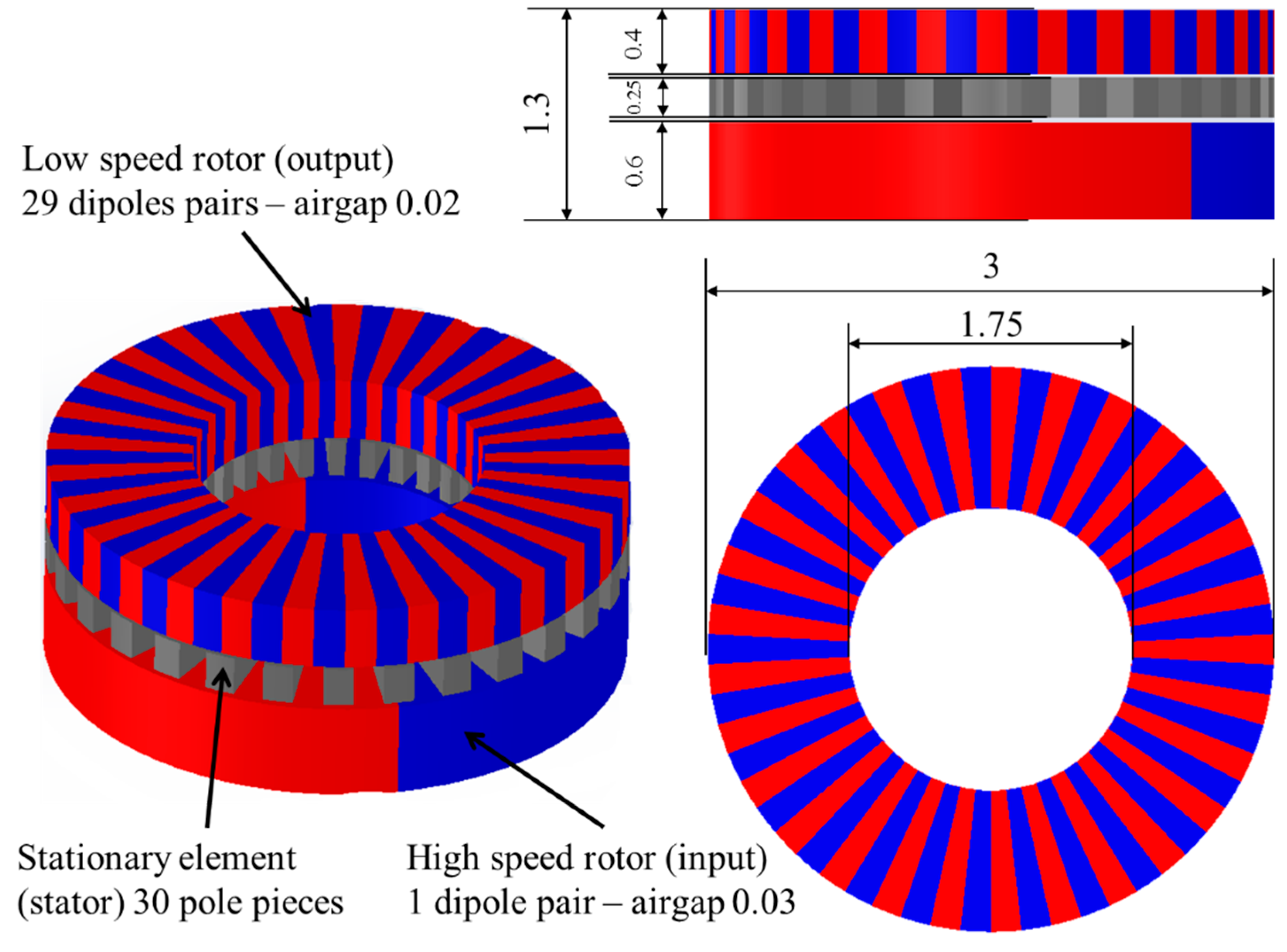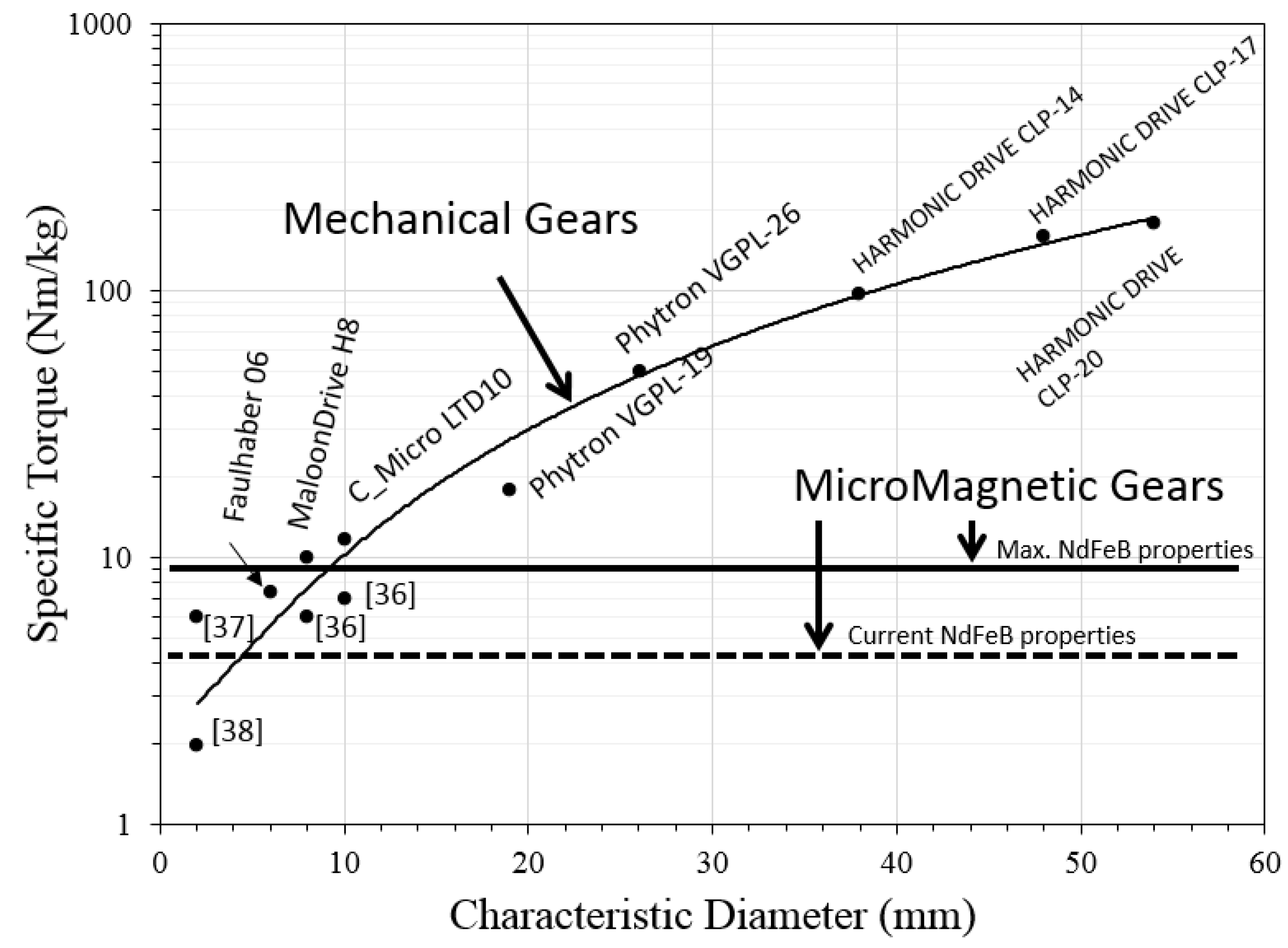Towards Miniaturization of Magnetic Gears: Torque Performance Assessment
Abstract
:1. Introduction
2. Micromagnetic Gear Design
3. Simulation Results
4. Micromagnetic Gears vs. Conventional Gears and Microgears
5. Conclusions
Acknowledgments
Author Contributions
Conflicts of Interest
References
- Subhash, G.; Corwin, A.D.; de Boer, M.P. Evolution of wear characteristics and frictional behavior in MEMS devices. Tribol. Lett. 2011, 41, 177–1891. [Google Scholar] [CrossRef]
- Dugger, M.T. Wear mechanisms in a reliability methodology. In Proceedings of the SPIE—The International Society for Optical Engineering, Reliability, Testing, and Characterization of MEMS/MOEMS, San Jose, CA, USA, 25–31 January 2003; Volume 4980, pp. 22–40. [Google Scholar]
- Ku, I.S.Y.; Reddyhoff, T.; Holmes, A.S.; Spikes, H.A. Wear of silicon surfaces in MEMS. Wear 2011, 271, 1050–1058. [Google Scholar] [CrossRef]
- Iannacci, J. Reliability of MEMS: A perspective on failure mechanisms, improvement solutions and best practices at development level. Displays 2015, 37, 62–71. [Google Scholar] [CrossRef]
- Wu, H.-W.; Chen, Y.-Y.; Horng, J.-H. The analysis of three-body contact temperature under the different third particle size, density, and value of friction. Micromachines 2017, 8, 302. [Google Scholar] [CrossRef]
- Penkov, O.; Khadem, M.; Nieto, A.; Kim, T.-H.; Kim, D.-E. Design and Construction of a Micro-Tribotester for Precise In-Situ Wear Measurements. Micromachines 2017, 8, 103. [Google Scholar] [CrossRef]
- De Pasquale, G.; Soma, A.; Barbato, M.; Meneghesso, G. Impact wear and other contact effects on the electro-mechanical reliability of MEMS. In Proceedings of the 2014 Symposium on Design, Test, Integration and Packaging of MEMS/MOEMS (DTIP), Cannes, France, 1–4 April 2014; pp. 1–6. [Google Scholar]
- Tambe, N.S.; Bhushan, B. Scale dependence of micro/nano-friction and adhesion of MEMS/NEMS materials, coatings and lubricants. Nanotechnology 2004, 15, 1561–1570. [Google Scholar] [CrossRef]
- Tauviqirrahman, M.; Ismail, R.; Jamari, J.; Schipper, D.J. Friction reduction in lubricated-MEMS with complex slip surface pattern. Procedia Eng. 2013, 68, 331–337. [Google Scholar] [CrossRef]
- Carpick, R.W.; Flater, E.E.; VanLangendon, J.R.; de Boer, M.P. Friction in MEMS: From single to multiple asperity contact. In Proceedings of the SEM VIII Intermational Congress & Exposition on Experimental & Applied Mechanics, Milwaukee, WI, USA, 10–12 June 2002; pp. 282–3287. [Google Scholar]
- Jorgensen, F.; Andersen, T. Two dimmensional model of a permanent magnet spur gear. In Proceedings of the Fourtieth IAS Annual Meeting Industry Applications Conference, Hong Kong, China, 2–6 October 2005; Volume 1–4, pp. 261–265. [Google Scholar]
- Huang, C.-C.H.C.-C.; Tsai, M.-C.T.M.-C.; Dorrell, D.G.; Lin, B.-J.L.B.-J. Development of a magnetic planetary gearbox. IEEE Trans. Magn. 2008, 44, 403–412. [Google Scholar] [CrossRef]
- Rens, J.; Atallah, K.; Calverley, S. A novel magnetic harmonic gear. IEEE Trans. Ind. Appl. 2010, 46, 206–212. [Google Scholar] [CrossRef]
- Niguchi, N.; Hirata, K. Cogging torque analysis of magnetic gear. IEEE Trans. Ind. Electron. 2012, 59, 2189–2197. [Google Scholar] [CrossRef]
- Holehouse, R.C.; Atallah, K.; Wang, J. A linear magnetic gear. In Proceedings of the 2012 XXth International Conference on Electrical Machines (ICEM), Marseille, France, 2–5 September 2012; pp. 563–569. [Google Scholar]
- Atallah, K.; Wang, J.; Howe, D. A high-performance linear magnetic gear. J. Appl. Phys. 2005, 97. [Google Scholar] [CrossRef]
- Yao, Y.D.; Huang, D.R.; Lee, C.M.; Wang, S.J.; Chiang, D.Y.; Ying, T.F. Magnetic coupling studies between radial magnetic gears. IEEE Trans. Magn. 1997, 33, 4236–4238. [Google Scholar] [CrossRef]
- Tlali, P.M.; Wang, D.R.J.; Gerber, S. Magnetic Gear Technologies: A Review. In Proceedings of the 2014 International Conference on Electrical Machines (ICEM), Berlin, Germany, 2–5 September 2014. [Google Scholar]
- Davey, K.; McDonald, L.; Hutson, T. Axial flux cycloidal magnetic gears. Magn. IEEE Trans. 2014, 50. [Google Scholar] [CrossRef]
- Jørgensen, F.T.; Andersen, T.O.; Rasmussen, P.O. The cycloid permanent magnetic gear. IEEE Trans. Ind. Appl. 2008, 44, 1659–1665. [Google Scholar] [CrossRef]
- Diez-Jimenez, E.; Musolino, A.; Rizzo, R.; Tripodi, E. Analysis of the static and dynamic behavior of a non hysteretic superconductive passive magnetic linear bearing by using an electromagnetic integral formulation. Prog. Electromagn. Res. M 2016, 50, 183–193. [Google Scholar] [CrossRef]
- Diez-Jimenez, E.; Perez-Diaz, J.-L.; Garcia-Prada, J.C. Local model for magnet–superconductor mechanical interaction: Experimental verification. J. Appl. Phys. 2011, 109, 063901. [Google Scholar] [CrossRef]
- Afsari, S.A.; Heydari, H.; Dianati, B. Cogging torque mitigation in axial flux magnetic gear system based on skew effects using an improved quasi 3-D analytical method. IEEE Trans. Magn. 2015, 51. [Google Scholar] [CrossRef]
- Cristache, C.; Diez-Jimenez, E.; Valiente-Blanco, I.; Sanchez-Garcia-Casarrubios, J.; Perez-Diaz, J.L. Aeronautical magnetic torque limiter for passive protection against overloads. Machines 2016, 4, 17. [Google Scholar] [CrossRef]
- Diez-Jimenez, E. Design and analysis of a non-hysteretic passive magnetic linear bearing for cryogenic environments. Proc. Inst. Mech. Eng. Part J J. Eng. Tribol. 2014, 228, 1071–1079. [Google Scholar] [CrossRef] [Green Version]
- Perez-Diaz, J.L.; Diez-Jimenez, E. Performance of magnetic-superconductor non-contact harmonic drive for cryogenic space applications. Machines 2015, 3, 138–156. [Google Scholar] [CrossRef]
- Li, X.; Chau, K.T.; Cheng, M.; Hua, W. Comparison of magnetic-geared permanent magnet machines. Prog. Electromagn. Res. 2013, 133, 177–198. [Google Scholar]
- MAGSOAR SL. 2017. Available online: www.magsoar.com (accessed on 1 September 2017).
- Zheng, P. Magnetic MEMS and Its Applications; Florida State University: Tallahassee, FL, USA, 2004. [Google Scholar]
- Makita, S.; Science, C.; Ikuta, K.; Arimoto, S. Non-contact magnetic gear for micro transmission mechanism. In Proceedings of the IEEE Micro Electro Mechanical Systems, An Investigation of Micro Structures, Sensors, Actuators, Machines and Robots, Nara, Japan, 30 December–2 January 1991; pp. 125–130. [Google Scholar]
- Garraud, A.; Dempsey, N.M.; Arnold, D.P. Microscale magnetic patterning of hard magnetic films using microfabricated magnetizing masks. In Proceedings of the IEEE International Conference on MEMS, San Francisco, CA, USA, 26–30 January 2014; pp. 520–523. [Google Scholar]
- Arnold, D.P.; Wang, N. Permanent magnets for MEMS. J. Microelectromech. Syst. 2009, 18, 1255–1266. [Google Scholar] [CrossRef]
- Dempsey, N.M.; Le Roy, D.; Marelli-Mathevon, H.; Shaw, G.; Dias, A.; Al, E. Micro-magnetic imprinting of high field gradient magnetic flux sources. Appl. Phys. Lett. 2014, 104, 262401. [Google Scholar] [CrossRef]
- Esnoz-Larraya, J.; Valiente-Blanco, I.; Cristache, C.; Sanchez-Garcia-Casarrubios, J.; Rodriguez-Celis, F.; Diez-Jimenez, E.; Perez-Diaz, J.L. Optimagdrive: High-performance magnetic gears development for space applications. In Proceedings of the ESMATS 2017, Hatfield, UK, 20–22 September 2017. [Google Scholar]
- Diez-Jimenez, E.; Esnoz-Larraya, J.; Valiente-Blanco, I.; Cristache, C. Lubrication free magnetic harmonic drives for harsh space environments. In Proceedings of the Space Robotics Symposium, Glasgow, UK, 29–30 October 2015. [Google Scholar]
- Degen, R.; Slatter, R. High Speed and Low Weight Micro Actuators for High Precision Assembly. In Proceedings of the IFIP TC5 WG5.5 Third International Precision Assembly Seminar (IPAS ’2006), Bad Hofgastein, Austria, 19–21 February 2006. [Google Scholar]
- Ishida, M.; Takeda, H. Wear resistivity of super-precision microgear made of Ni-based metallic glass. Mater. Sci. Eng. A 2007, 449–451, 149–154. [Google Scholar] [CrossRef]
- Kim, J.H.; Jung, I.S.; Sung, H.G. Design and manufacturing of ultra small actuator. In Proceedings of the 2006 IEEE International Conference on Mechatronics (ICM 2006), Budapest, Hungary, 3–5 July 2006; pp. 23–26. [Google Scholar]



© 2017 by the authors. Licensee MDPI, Basel, Switzerland. This article is an open access article distributed under the terms and conditions of the Creative Commons Attribution (CC BY) license (http://creativecommons.org/licenses/by/4.0/).
Share and Cite
Diez-Jimenez, E.; Sanchez-Montero, R.; Martinez-Muñoz, M. Towards Miniaturization of Magnetic Gears: Torque Performance Assessment. Micromachines 2018, 9, 16. https://doi.org/10.3390/mi9010016
Diez-Jimenez E, Sanchez-Montero R, Martinez-Muñoz M. Towards Miniaturization of Magnetic Gears: Torque Performance Assessment. Micromachines. 2018; 9(1):16. https://doi.org/10.3390/mi9010016
Chicago/Turabian StyleDiez-Jimenez, Efren, Rocio Sanchez-Montero, and Miriam Martinez-Muñoz. 2018. "Towards Miniaturization of Magnetic Gears: Torque Performance Assessment" Micromachines 9, no. 1: 16. https://doi.org/10.3390/mi9010016




